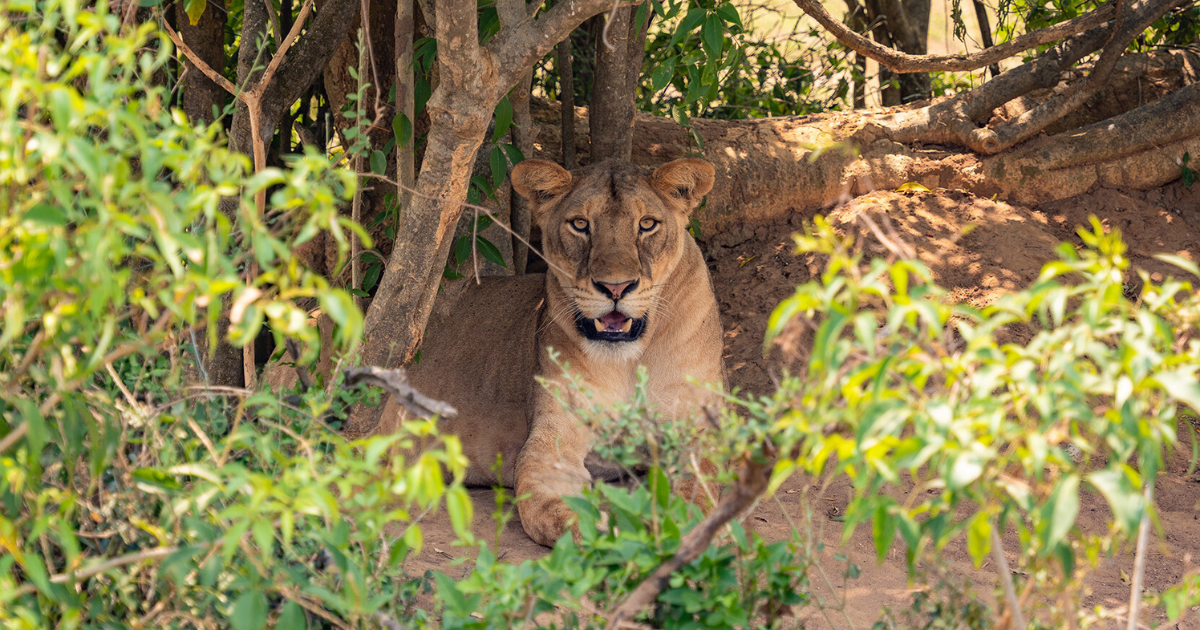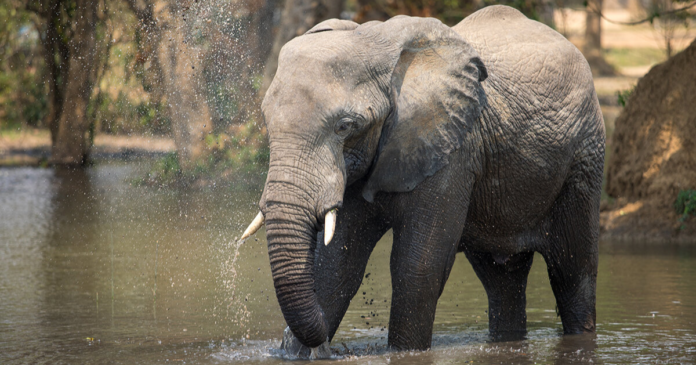With fifteen years since my last trip to Africa, and this being my first visit to a nation in East Africa, it was a completely new experience. Uganda, known as the Pearl of Africa, is one of four countries that edge Lake Victoria—the largest lake on the continent — and source of the White Nile River. Here, where the greatest river in the world begins its odyssey, I began my journey.
After landing almost directly on the equator in Entebbe, Uganda, I walked around colorful markets, watched anglers haul tilapia to the shores of the lake, and ate juicy pineapple freshly harvested from the agricultural islands that dot the water. I enjoyed the sights, sounds, and feel of bustling life into the evening before ensuring a good rest in preparation for the adventure to come.

Shuttled on a tiny Cessna with the crew of Epic Trails, we landed at the Kihihi airstrip—a red strip of dirt not far from Bwindi Impenetrable National Forest, the legendary home of the mountain gorillas.
Uganda is one of only three countries in the world where mountain gorillas remain in the wild. And while Rwanda and the Democratic Republic of Congo are doing their part to care for these endangered species, Uganda boasts being home to approximately half the remaining gorillas in the wild, as well as the most mountainous and wild terrain in which to experience them.
Uganda is playing a critical role in the protection and preservation of the mountain gorillas. While scientists and conservationists are drawn from all over the world to learn from and safeguard these primates, the work that Ugandan nationals are doing is of critical importance. From local farmers surrounding the national parks, the scientists and researchers that are studying and implementing helpful protocols, to the local rangers who protect the gorillas from poachers, Uganda’s robust approach to conservation has been a great success. Gorilla trekking is a central part of the conservation efforts. For many, myself included, trekking through the lush, mountainous forests in hopes of spotting a group is truly a bucket-list worthy experience.
Gorilla trekking, my raison d’être in Uganda in the first place, was something I have long dreamed about. Silverback gorillas, the dominant males of the mountain gorilla species, seem almost mythical. Anyone who grew up watching nature documentaries has surely been amazed by tantalizing imagery of these gorillas. I don’t know how anyone could not feel a tug of the heartstrings when looking into the eyes of a baby gorilla clinging to its mother’s back or playing with siblings.
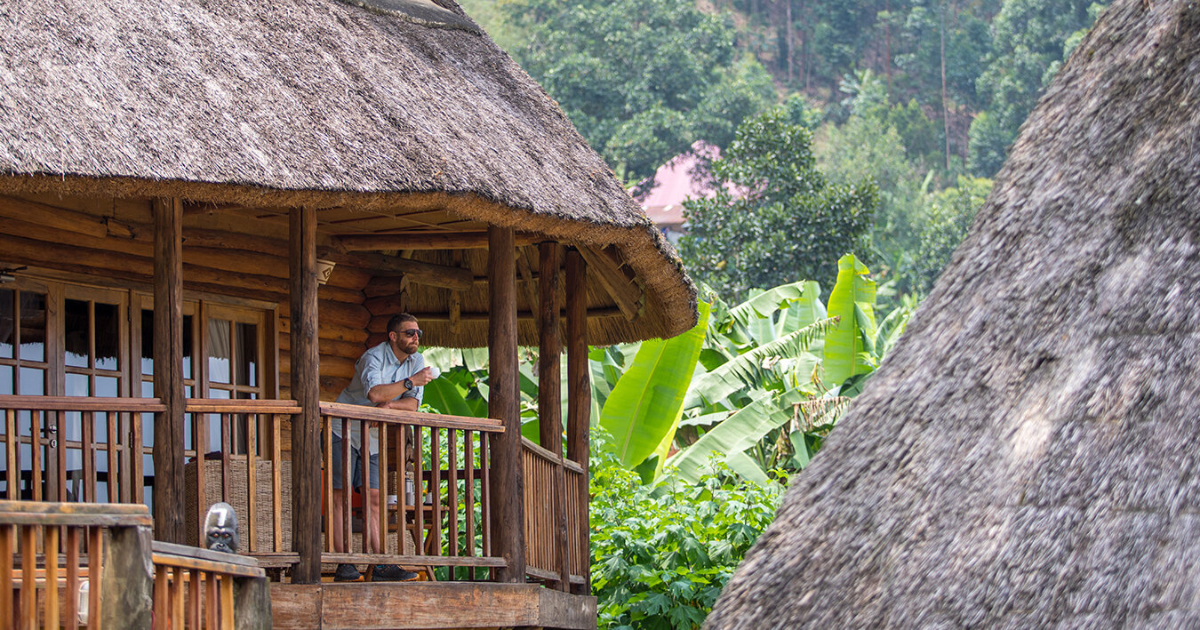
Needless to say, I was barely able to contain my excitement as I drove in an iconic safari-style Land Cruiser up the cobbly red road of Bwindi village and through the gates of the Tracker Safari Lodge.
The lodge is built on the mountainside just outside Bwindi Impenetrable National Forest with elevated wooden walkways leading to individual accommodations built of wood, grass, and traditional materials upon stilts. Nestled in the jungle, it all had a dreamlike-Peter-Pan-infused architecture that was also elegant and luxurious.
I rarely get excited about hotels and lodges. Give me a tent perched atop a cliff and I am happy. But the Tracker Safari Lodge had me giddy, feeling like a boy on a grand adventure.
Waking before the sun, I scarfed an omelet and downed a pot of coffee before making my way to the gates of Bwindi Impenetrable National Forest. Meeting up with Cosmas Tumuramye, a local guide who has worked with the gorillas for years, his enthusiasm for them was hard to miss. Cosmas informed us that we would be following the Mubare group, one of the oldest gorilla clans in the national park to be habituated and made familiar with humans.
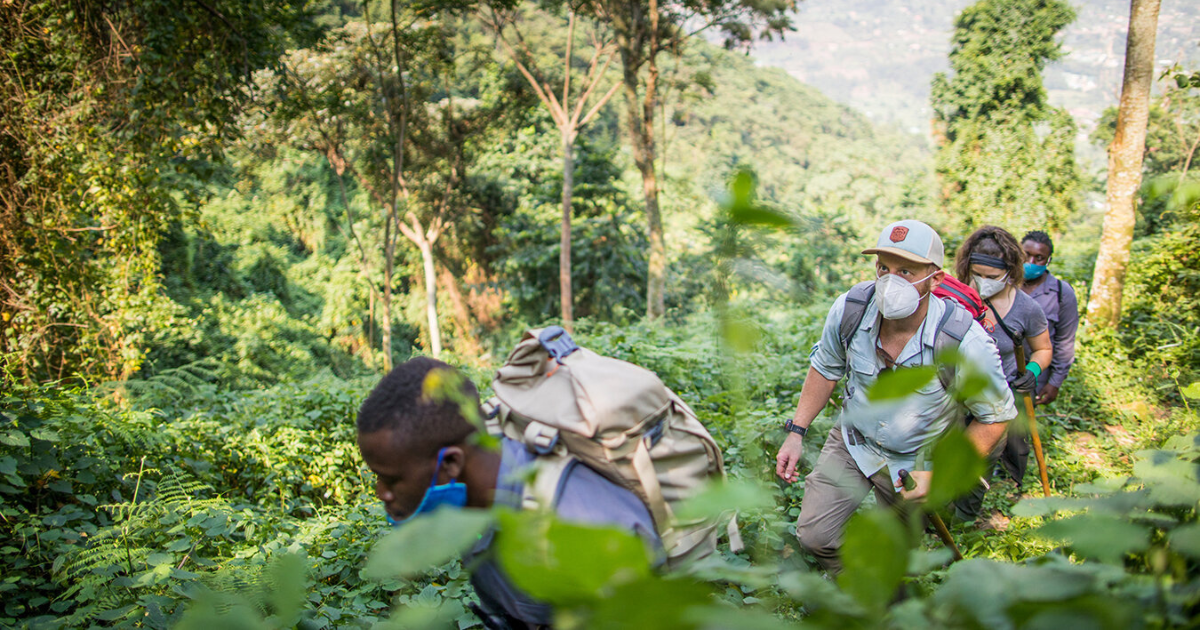
I should note, that all of this happened during the COVID-19 pandemic. In part due to safeguarding gorillas, and otherwise because of global travel bans that varied from country to country, gorilla trekking nearly slowed to a halt, hugely impacting the local economy. With little to no work coming in, people around Bwindi had a very difficult year. Hope looks beyond the pandemic and are buoyed by a recent baby boom in the gorilla population. The Mubare group we followed, which consisted of a chief silverback and four females, just welcomed four adorable newborn baby gorillas.
For those unfamiliar, gorillas share 98% of DNA with humans. Our kinship means that gorillas are also susceptible to human diseases, including the coronavirus. To help protect people working with gorillas, as well as the gorillas themselves, I needed to wear an N95 mask along the entire trek. Other protocols have been instituted as well for the safety of everyone involved.
The protocols, as I learned from Dr. Gladys Kalema-Zikusoka right before the trek, are an important part of the protection not only of the gorillas but of the communities surrounding the endangered species. This relationship is the driving idea behind the organization she founded: Conservation Through Public Health. Keep people healthy and thriving. Keep gorillas healthy and thriving.

I was happy to do my small part.
After three hours of trekking, we had left behind the valley floor and hiked approximately two thousand feet up into the mountains. Here we officially crossed into the Bwindi Impenetrable National Park. I immediately understood the name. The forest was dense with towering trees and dangling vines that wove the entire forest together. Progress would have been incredibly difficult without the excellent trailblazing work performed by the elephants here, who bulldoze their way through the dense jungle, uprooting trees and tearing vines—singlehandedly creating pathways for us to follow the gorillas.
Chatter on the radio picked up. The advanced scouts, a team of trackers who monitor the movements and activity of the gorillas every day, had a lead on the Mubare group. We were getting close. Cosmas called the team together. He began a briefing of what to expect, how to ensure our own safety as well as that of the gorillas, when right behind me I heard a loud grunt.
I turned around to see the vines directly behind me being pulled and torn loose. At that moment, a baby gorilla clambered up into a small tree and I got my first glimpse of the mountain gorillas. The baby climbed high into the tree, quickly overburdening the young sapling, which broke under the weight of the tyke. The baby gorilla crashed harmlessly back to the forest floor.
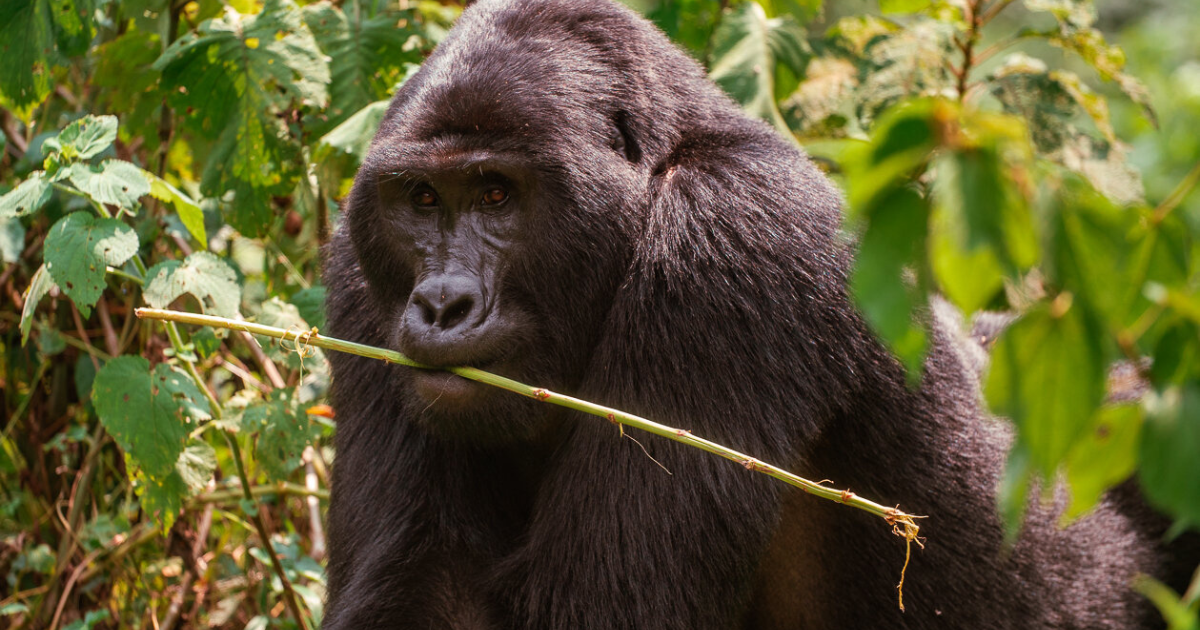
Unexpectedly, I welled up with emotion. I was unprepared for the surge of sentiment at seeing these beautiful creatures. Their humanlike faces, their playful behavior, and more than anything, their soulful eyes tugged at my heart in a way I couldn’t have predicted.
For an hour, our group watched in awe at every movement of the gorillas. We had to keep our distance, but even thirty feet of space between a massive silverback and me felt like we could practically touch. Or at least, he could close that distance in the blink of an eye and pummel me tender as a skirt steak.
But mountain gorillas, while incredibly powerful and muscular, are calm and docile. They moved slowly, lounging in the shade and pulling vegetation into their mouths constantly, which I suppose is necessary when you eat over 20 kilograms of jungle salad every day.
Our hour with the gorillas passed like a dream. It was magical. But in order to keep the gorillas from being over-stressed by human contact, we had to move on. I was sad to return back down the mountain. I wanted to stay like Jane Goodall and make my new home in the impenetrable forest.
Gorilla trekking is an incredible experience, one I won’t soon forget. But this day was also a reminder to me that many people around the world have had a very different experience with COVID than I have. Most of the people in Bwindi had been out of work for a year. My trek was among the first the guides, porters, and scouts had worked on. Fees paid for trekking permits go to conservation efforts throughout Uganda and the near-zero tourism has made all wildlife conservation difficult. My hope, of course, is that when the tides of the pandemic have turned, people will be able to safely travel and these communities will rebound vibrantly.
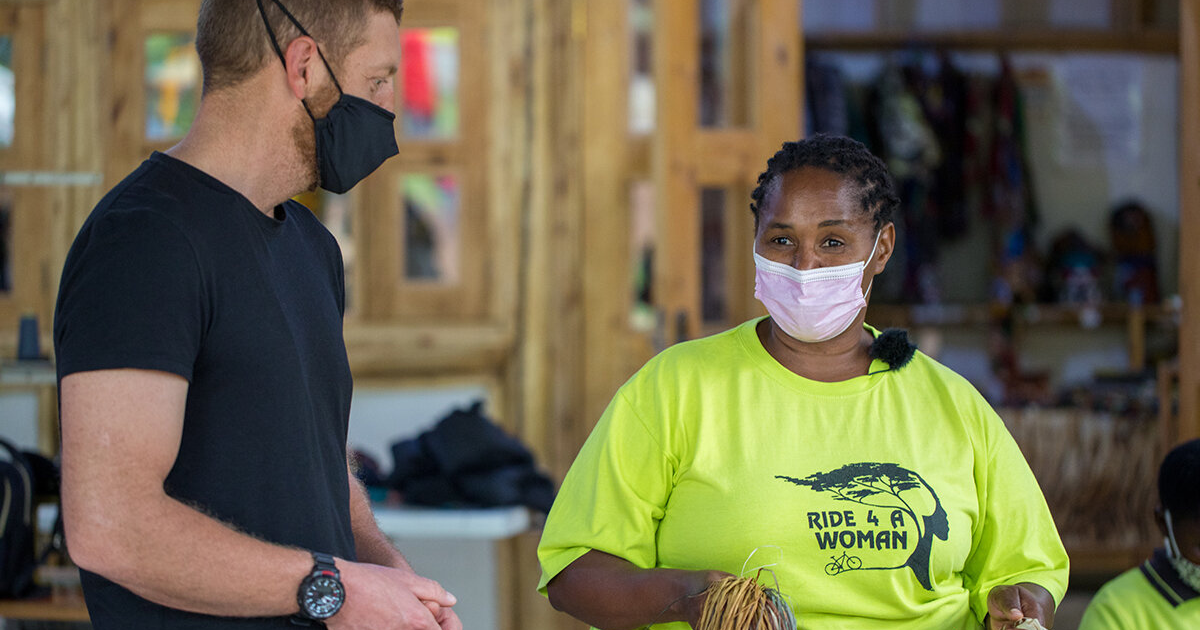
Nowhere is the vibrance of the communities more on display than at Ride 4 a Woman, an organization established in 2009 to support women struggling with poverty, domestic violence, and issues associated with HIV. I had the opportunity to meet up with Evelyne Habasa, founder of Ride of 4 a Woman, to learn about how this group is helping 300+ women from eleven surrounding villages. These women come together to learn to pedal sew, weave baskets, dance, sing, drum, and support one another. The organization also has an incredible microfinancing program empowering women with social and economic skills used to support their families and community. Everyday women arrive at the Buhoma community hub to work at creating beautiful baskets and clothing. Their crafts are incredible, and I loved being welcomed to weave alongside these talented women in the traditional style.
That evening, a team from Ride 4 a Woman came up to the Tracker’s Safari Lodge to put on a show. Equipped with drums, cymbals, and an array of traditional instruments, the women danced. Of course, it didn’t take long for them to welcome me, again, and I learned to dance alongside them. It was an evening full of joy, laughter, exhausting dancing, and inspiration. It was truly memorable.
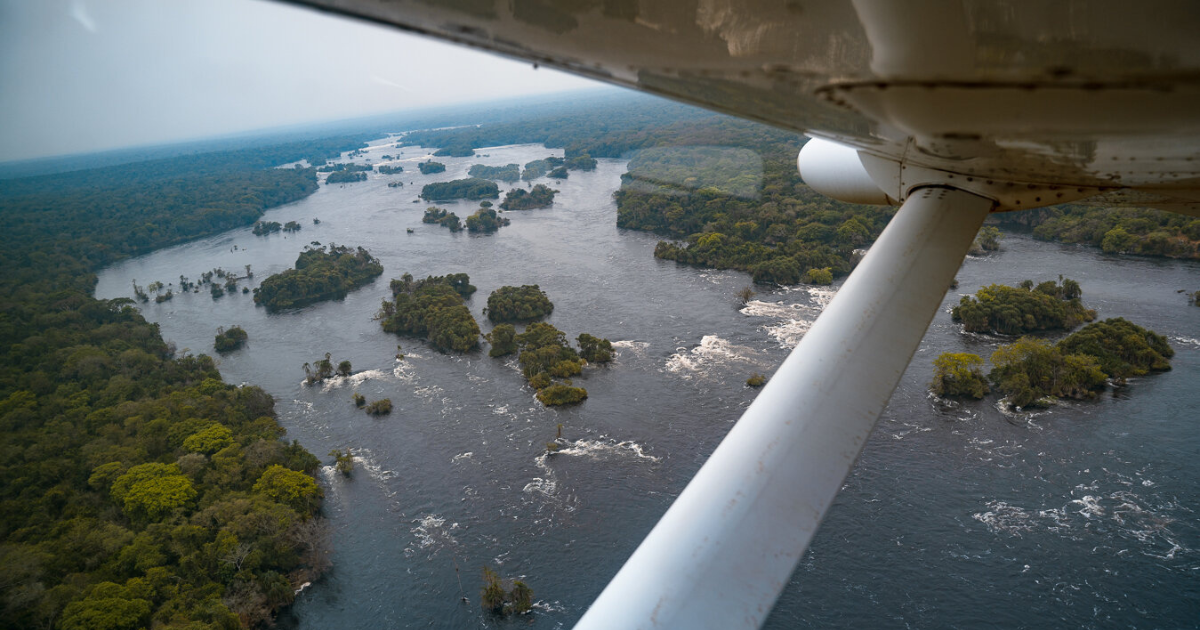
In the morning I hopped back on the Cessna and was flown to Murchison Falls National Park. Murchison Falls stands in stark contrast to the lush mountains and forests of Bwindi. The national park is split by the White Nile on its journey north as one of the greatest rivers on the planet. The banks of the river are verdant and full of hundreds of species of birds. A large concentration of hippos graze in the river. Elephants drink and play in the shallows. Away from the Nile, the land is hot and dry savannah, but still full of wildlife. But the headliner of this incredible place, the namesake, is Murchison Falls.
Here the White Nile picks up steam, thundering over an ancient rift in the tectonic plates and churning through a narrow gorge. It’s one of the most powerful and beautiful waterfalls in all of Africa, or anywhere in the world for that matter. Our talented pilots were courteous and flew low over the falls, giving us a glimpse of the beautiful chaos before landing on the airstrip that ends quite literally on the grounds of the Chobe Safari Lodge.
I walked through the Chobe Safari Lodge, an impressive edifice perched above the Nile, as swifts darted in and out through the hotel’s large open windows. I walked out onto the lodge’s patio to see a squadron of hippo standing in the shallow water, grazing, nuzzling, playing, and occasionally fighting with each other. These behemoths were only a stone’s throw from where I ate lunch. Warthogs wandered the grounds and monkeys swung about in the trees. I didn’t even have to leave the lodge to go on safari.
But I did nonetheless.
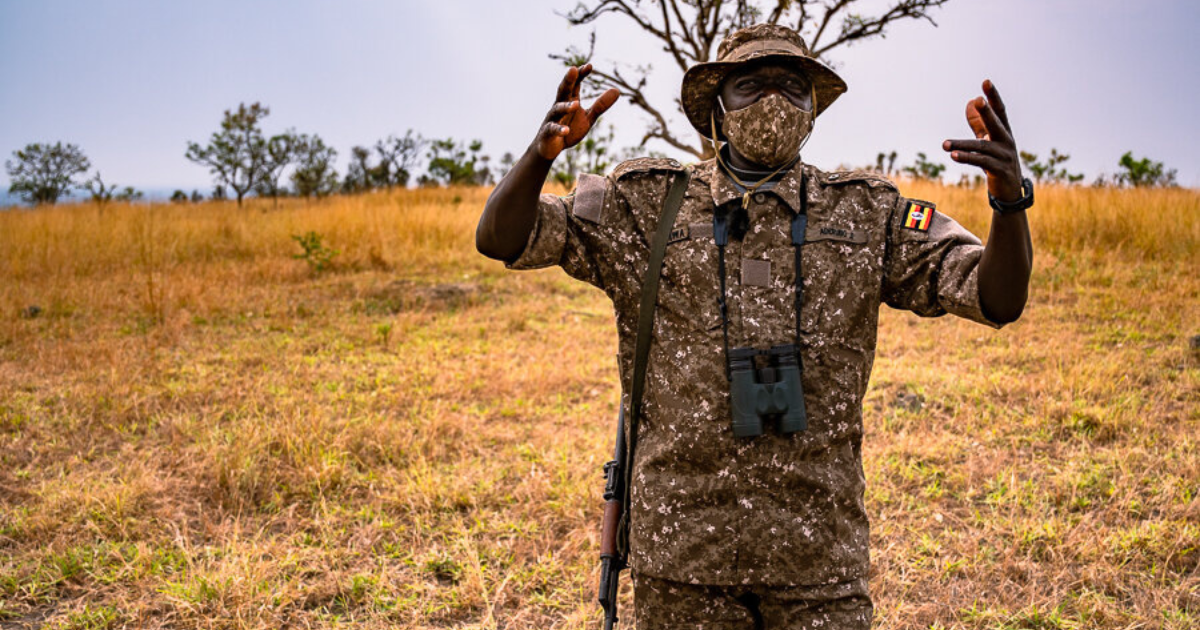
I awoke at 5 am to meet up with Dennis, a ranger and wildlife expert in the national park. We drove through the dark savannah as barely visible elephants surged away from the road and our oncoming Land Cruiser. As the sun emerged, I noticed just how much wildlife there was in the national park. Buffalo, giraffe, elephants, baboons, antelope, lions, and more. As the sun was first rising, I was excited to spot anything. But I quickly learned that I didn’t need a keen eye. The wildlife was everywhere, engulfing me. Every few minutes Dennis would exclaim the wonders of another herd of giraffe, and tell an enthusiastic tale. Dennis was charming and passionate, like a Ugandan Steve Irwin.
Of course, the day did not end with ONLY a few hundred thousand animals spotted on safari. Eventually Dennis pulled the Land Cruiser to a halt. We got out and hiked. A roar came thundering over the hill as I emerged at the top. There before me stood Murchison Falls in all its thundering glory.
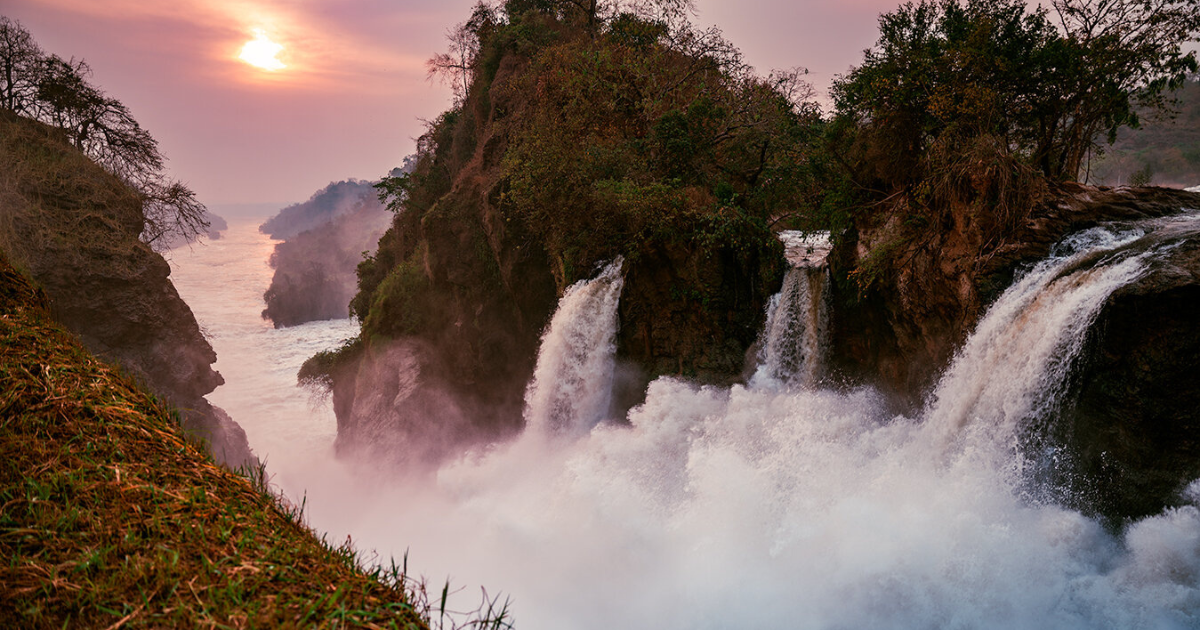
To stand at the edge of Murchison Falls is to stand atop pure chaos, unfathomable energy, and bowel-loosening power. The ground was literally shaking beneath my feet.
The wet season had unleashed massive flooding so the Nile was flowing at record-breaking highs. This meant that Murchison Falls had even more colossal power than normal. It took my breath away.
The sun was setting in perfect view down the gorge as the spume of the falls lifted high into the air. The ephemeral beauty of the moment felt like summary of my experience in the Pearl of Africa, wonderous, powerful, pure. It was a fitting end to my adventure in Uganda.
